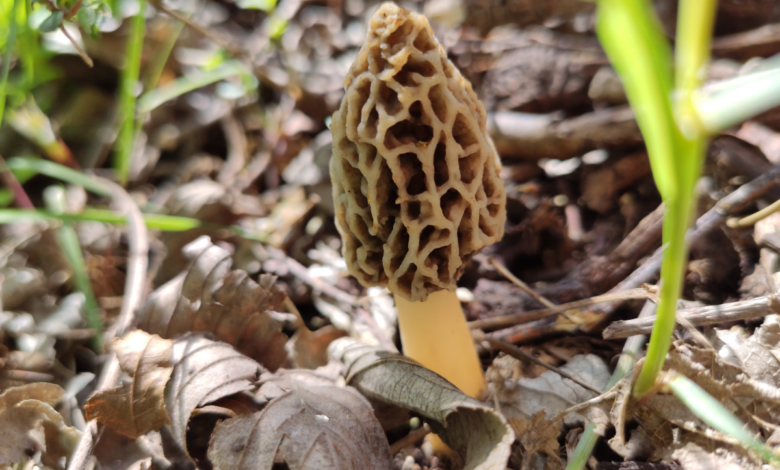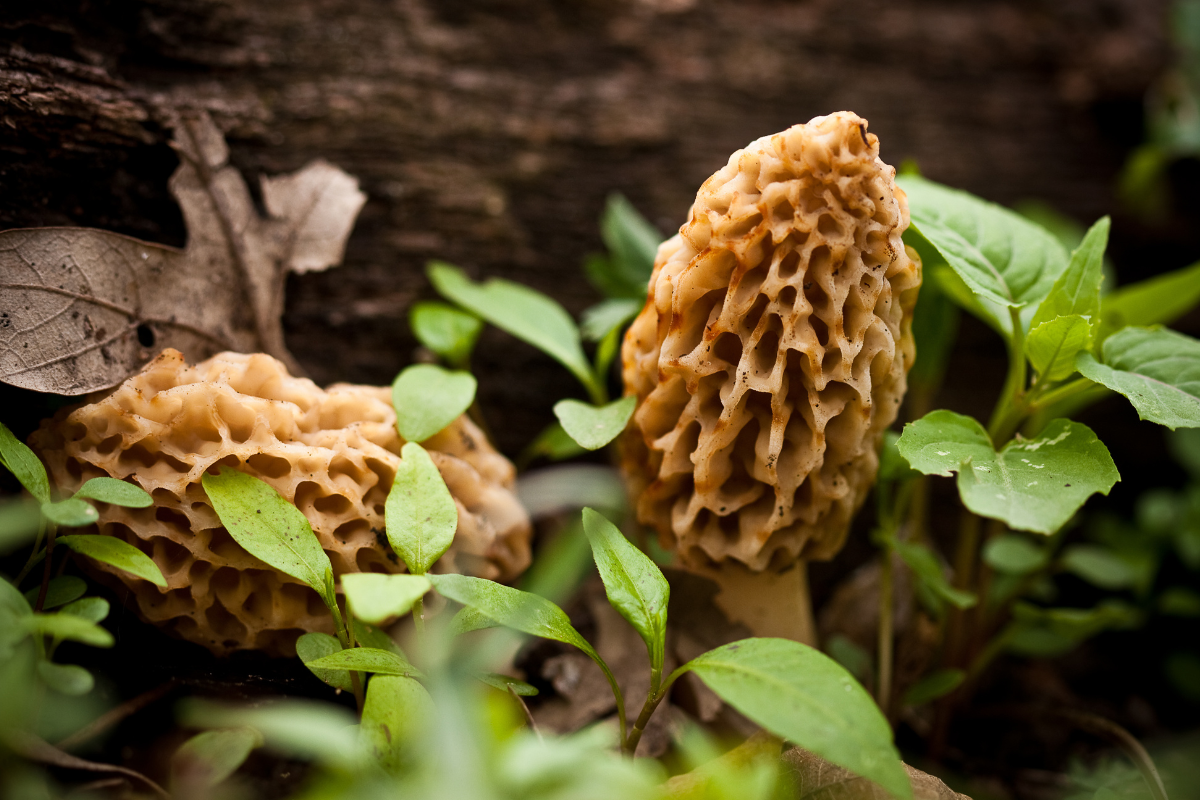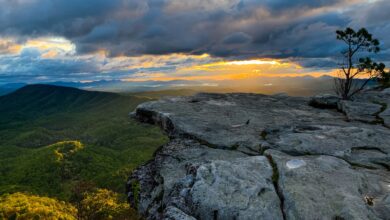Best Places to Find Morel Mushrooms

Think of a world where people have an unusual job that is covered by a veil of secrecy.
Yes, I am talking about the task of wild mushroom hunting. It is said that searching for mushrooms in the woods is like a treasure hunt. And if you meet a morel mushroom hunter, one question you should never ask is – so where do you hunt for those morels?
Trust me, things can get awkward with such questions.
Since I started hunting for morels from a young age, I know the best spots to look for them. But if you are new to this task, do not expect fellow hunters to guide you. You will need to find your own morel hot spots.
The good news is that hunting for morels becomes a lot easier when you know where to look. To help you out, we have listed some of the best places to find morel mushrooms.
Fallen and Rotting Trees
If you have found fallen timber in the woods in spring, great.
The chances are that there will be morels around it. Trees that have fallen last season and are in a partially decayed condition are the best.
Quite simply, the dead wood and decaying leaves are an excellent food source for the mushrooms. Mushrooms are saprophytes, natural decomposers that fasten the process of organic breakdown for the decaying matter by releasing specific enzymes.
That way, they play a vital role in maintaining the forest ecology. And as the tree decomposes, it keeps adding nutrients to the surrounding soil.
Plus, the moisture and shade around the edges of the trunk make the environment ideal for their growth. If you are lucky, you might find them growing around fallen branches and dead stumps as well. If there is a creek or a riverbed nearby, even better.
Some trees that morels prefer as neighbors are Ash, Elm, Hickory, and Sycamore. This is one behavior of morels that remains mysterious. Some think that they have a symbiotic relationship with the trees. However, the exact nature of the relationship remains unclear.
Generally, old trees that are dying will have layers of bark slipping off trunks. The reason why morels grow around the roots of such dying trees can be the same- the promise of a food-rich environment in the future.
Ash From Wildfires
What makes morels rise like a phoenix from the ashes left behind by a forest fire?
The truth is no one knows for sure. A few theories have been proposed, but none have been proven scientifically. They might be hiding below the ground for years, waiting for a wildfire to burn out the landscape.
One theory suggests that morels have a relationship with specific plant species. The roots of these hot trees provide sugars and carbs to the fungus. When these trees are gone, the fungus produces more morels to generate more spores and disperse. I guess the morel motto is – reproduce or die.
Generally, if there is a forest fire, you can expect the post-fire morel production for the first year to be very high. In states like Oregon, and Alaska, a steep rise in morel abundance in the spring after forest fires has been statistically proven.
A few years back, I saw hundreds of morels growing on a burnt patch the size of a cabin tent, in Schneider Springs. Honestly, I have never seen such a dense growth pattern of the mushrooms before.
In a study conducted at a site in the Yosemite National Park, morels were found growing on ground that was completely burned by fire. Interestingly, these are spots where the fire left nothing behind except ash, blackened soil, and burnt needles.
These are the burn morel that generally grow in burned conifer forests. There are five species of the burn morel and some may grow in deciduous forests as well.
Even in regions in the Midwest, Northeast, and the Great Plains, you will find morels growing on grounds burned by low-intensity grass fires. These can be around waterways or wooded areas.

Southern Side of Tree Cover
In early spring, the slopes facing south are the ones you need to check. These slopes receive the maximum sun and the soil warms up quickly.
A soil temperature in the 45-55 degree range for 3-4 days is what morels prefer and the daytime warmth helps with that. Combine a few days of favorable temperature with some rain and you will find morels popping up on the slopes.
I have to add that dampness is critical for mushroom growth. At the same time, they will not grow near stagnant water or swampy zones. They do not prefer hard, dry soil either. In slopes, the conditions are favorable as the water drains downward leaving the soil moist. The ones with ample tree cover and well-drained soil are the best spots.
At the tail end of the season, I try the opposite. When temperatures are above 70 degrees, I focus on the north-facing slopes that offer cooler temperatures.
And if you find a few morels, you will most likely find a few more within a 20-25-foot radius. While the surface growth may not be there, the fungus has an expansive network below the soil. In any case, look around.
I have also found morels along ridges and tree clusters. Some of these spots have dying trees which is even better for morel growth. It is not that they do not grow on grassy slopes, but the higher humidity around trees works better.
When Do Morels Bloom?
In general, April and May are the best months for morel hunting. But the exact dates can vary depending on your latitude and elevation. In some areas, they can start growing in mid-March. Also, they do not start appearing at the same time every year.
In short, there is no single equation to predict the perfect time for morel hunting. A lot of climatic factors need to come together to make them emerge. But, that complexity makes hunting for them even more fun.
Look out for temperatures hitting the sixties in the daytime and forties at night consistently for a few days. When the ground temperatures are rising and the spring rains have come down, it is time to head out.
Some of my best morel hunts have been during cloudy and rainy spring days. I have to say, nothing compares to the fresh smell of the woods on a wet spring morning.
Since morels do not follow calendars, one thing you can do is to look out for nature’s clues. For example, one indicator species for ideal morel conditions is the mayapple (Podophyllum peltatum). If you find this wildflower blooming in the woods, there is a high chance of finding morels. Other signs like apple trees budding and daffodils blooming can work too.
Now, morels growing in the north may not follow the same pattern as those growing in the south. But it is still worth checking out the woods based on the clues.
What is the Best Time of Day to Find Morel Mushrooms?
Quite simply, you need a good amount of light to locate morels in the woods. So, I do not prefer dawn and late afternoon hunts. That said, a lot depends on the area you are hunting. In some areas, the light in the early morning hours can create the right contrast that allows you to spot the mushrooms more easily.
Do not wait for the sun to clear the clouds or the rain to come down either. Wait too long and someone else might beat you to the prize. If you have a spot in mind, make sure to hit it before noon.
Where Do Morel Mushrooms Grow in the US?
You will find morel mushroom locations spread across almost every state in the US, as long as the conditions are favorable. That means no matter where you are, this is an activity that you can always enjoy. However, the chances of finding them are higher in certain geographical regions.
Here is a quick look at the general order of morel appearance in the states.
- The first of the morels appear in the southeast states of Alabama, Georgia, South Carolina, and the southern belt of Arkansas.
- Next in line are the states of Arkansas, North Carolina, Oklahoma, Virginia, and Maryland. The Appalachian region of Tennessee and Kentucky are also on this list.
- The southern parts of Ohio. West Virginia, Indiana, Missouri, Illinois, and Kansas are the states next in line.
After appearing in these states, the morels tend to make a northward progression. As the season begins in the north, the growth rate in the southern states comes down. Keep in mind that the window for finding morels in every region is short- around 3 weeks in most cases.
Missouri and Illinois are two of my favorite morel hunting destinations in the Midwest. On the West Coast, the forest fire sites in Oregon, Washington, and Northern California are some of the best spots.
Note, that the rate of growth of morels depends on the location. While they grow super quickly in most locations, in some regions like the Pacific Northwest, they can take around three weeks to mature.
Final Thoughts
The truth is, finding morels is not an exact science. Over the years, I have found them growing in some of the strangest places. I am sure that you will too.
At times morels can be incredibly difficult to find. But, some people seem to have a nose for them. For newbies, there is a learning curve that requires time and experience. Hopefully, this list of the best places to find morel mushrooms will help you to focus your search for this valued delicacy.
A warning though. If you hit a morel jackpot you are trapped. This treasure hunt can get super addictive.



